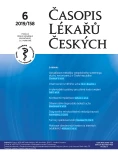Inner ear disorders
Authors:
Zdeněk Fík; Jan Bouček
Authors‘ workplace:
Klinika otorinolaryngologie a chirurgie hlavy a krku 1. LF UK a FN Motol, Praha
Published in:
Čas. Lék. čes. 2019; 158: 216-220
Category:
Review Article
Overview
Auditory part of the inner ear transforms mechanic energy to the electric energy. The key component of this process are hair cells, which damage leads to often irreversible hearing impairment. The damage can occur due to several external and internal causes and the treatment focuses mainly onto the mitigation of the consequences. Sometimes sensorineural hearing loss can be symptom of some severe disease and thus it can lead to its early diagnosis.
Keywords:
Tinnitus – hair cell – sudden sensorineural hearing loss – presbycusis
Sources
-
Petrovický P. Anatomie s topografií a klinickými aplikacemi, sv. 3. Osveta, Martin, 2002.
-
Dallos P. Cochlear amplification, outer hair cells and prestin. Curr Opin Neurobiol 2008; 18: 370–376.
-
Fettiplace R, Hackney CM. The sensory and motor roles of auditory hair cells. Nat Rev Neurosci 2006; 7: 19–29.
-
Singh S, Blakley B. Systematic review of ototoxic pre-surgical antiseptic preparations – what is the evidence? J Otolaryngol Head Neck Surg 2018; 47: 18.
-
Jing W, Zongjie H, Denggang F et al. Mitochondrial mutations associated with aminoglycoside ototoxicity and hearing loss susceptibility identified by meta-analysis. J Med Genet 2015; 52: 95–103.
-
Ralli M, D'Aguanno V, Di Stadio A et al. Audiovestibular Symptoms in Systemic Autoimmune Diseases. J Immunol Res 2018; 2018: 5798103.
-
Chrobok V, Pollak A, Šimáková E a kol. Záněty vnitřního ucha na podkladě chronického hnisavého středoušního zánětu s cholesteatomem (histologická studie). Otorinolaryngologie a foniatrie 2008; 57: 123–127.
-
Vrabec P. Rovnovážný systém II – speciální část. Triton, Praha, 2007.
-
Le TN, Straatman LV, Lea J, Westerberg B. Current insights in noise-induced hearing loss: a literature review of the underlying mechanism, pathophysiology, asymmetry, and management options. J Otolaryngol Head Neck Surg 2017; 46: 41.
-
Ryan AF. Protection of auditory receptors and neurons: evidence for interactive damage. Proc Natl Acad Sci U S A 2000; 97: 6939–6940.
-
Marx M, Younes E, Chandrasekhar SS et al. International consensus (ICON) on treatment of sudden sensorineural hearing loss. Eur Ann Otorhinolaryngol Head Neck Dis 2018; 135: S23–S28.
-
Plontke SK. Diagnostics and therapy of sudden hearing loss. GMS Curr Top Otorhinolaryngol Head Neck Surg 2017; 16: Doc05.
-
Wilson WR, Byl FM, Laird N. The efficacy of steroids in the treatment of idiopathic sudden hearing loss. A double-blind clinical study. Arch Otolaryngol 1980; 106: 772–776.
-
Sweeney AD, Carlson ML, Shepard NT et al. Congress of Neurological Surgeons systematic review and evidence-based guidelines on otologic and audiologic screening for patients with vestibular schwannomas. Neurosurgery 2018; 82: E29–E31.
-
Hentschel M, Scholte M, Steens S et al. The diagnostic accuracy of non-imaging screening protocols for vestibular schwannoma in patients with asymmetrical hearing loss and/or unilateral audiovestibular dysfunction: a diagnostic review and meta-analysis. Clin Otolaryngol 2017; 42: 815–823.
-
Aarnisalo AA, Suoranta H, Ylikoski J. Magnetic resonance imaging findings in the auditory pathway of patients with sudden deafness. Otol Neurotol 2004; 25: 245–249.
-
Janeček D, Lavička L, Bartoňková K. Možnosti terapie náhlých poruch sluchu. Otorinolaryngologie a foniatrie 2009; 58: 29–32.
-
Mukherjea D, Ghosh S, Bhatta P et al. Early investigational drugs for hearing loss. Expert Opin Investig Drugs 2015; 24: 201–217.
-
Lalwani A. Current Diagnosis & Treatment Otolaryngology – Head and Neck Surgery. McGraw-Hill, New York, 2011.
-
Svobodová V, Profant O, Plzák J et al. Asymetrická porucha sluchu. Otorinolaryngologie a foniatrie 2019; 68: 53–59.
-
Scholte M, Hentschel MA, Kunst HP et al. Potential savings in the diagnosis of vestibular schwannoma. Clin Otolaryngol 2018; 43: 285–290.
-
Stachler RJ, Chandrasekhar SS, Archer SM et al. Clinical practice guideline: sudden hearing loss. Otolaryngol Head Neck Surg 2012; 146: S1–S35.
-
Rosen S, Bergman M, Plester D et al. Presbycusis study of a relatively noise-free population in the Sudan. Ann Otol Rhinol Laryngol 1962; 71: 727–743.
-
Tyberghein J. Presbycusis and phonemic regression. Acta Otorhinolaryngol Belg 1996; 50: 85–90.
-
Tu NC, Friedman RA. Age-related hearing loss: Unraveling the pieces. Laryngoscope Investig Otolaryngol 2018; 3: 68–72.
-
Olze H, Knopke S, Grabel S et al. Rapid positive influence of cochlear implantation on the quality of life in adults 70 years and older. Audiol Neurootol 2016; 21(Suppl. 1): 43–47.
-
Knopke S, Grabel S, Forster-Ruhrmann U et al. Impact of cochlear implantation on quality of life and mental comorbidity in patients aged 80 years. Laryngoscope 2016; 126: 2811–2816.
-
Jastreboff PJ. Tinnitus retraining therapy. Prog Brain Res 2007; 166: 415–423.
-
Moller AR. Epidemiology of Tinnitus in Adults. In: Moller AR et al. (eds.). Textbook of Tinnitus. Springer, New York, 2011: 29–37.
-
Hazell JW. Tinnitus. II: Surgical management of conditions associated with tinnitus and somatosounds. J Otolaryngol 1990; 19: 6–10.
-
Jastreboff PJ. Phantom auditory perception (tinnitus): mechanisms of generation and perception. Neurosci Res 1990; 8: 221–254.
-
Tucker DA, Phillips SL, Ruth RA et al. The effect of silence on tinnitus perception. Otolaryngol Head Neck Surg 2005; 132: 20–24.
-
Hughes GB, Pensak ML. Clinical Otology. Thieme, 2011.
-
Bennett MH, Kertesz T, Perleth M et al. Hyperbaric oxygen for idiopathic sudden sensorineural hearing loss and tinnitus. Cochrane Database Syst Rev 2012; 10: CD004739.
-
Wang Q, Xue Y, Zhang Y et al. Genetic basis of Y-linked hearing impairment. Am J Hum Genet 2013; 92: 301–306.
-
Wilcox SA, Saunders K, Osborn AH et al. High frequency hearing loss correlated with mutations in the GJB2 gene. Hum Genet 2000; 106: 399–405.
Labels
Addictology Allergology and clinical immunology Angiology Audiology Clinical biochemistry Dermatology & STDs Paediatric gastroenterology Paediatric surgery Paediatric cardiology Paediatric neurology Paediatric ENT Paediatric psychiatry Paediatric rheumatology Diabetology Pharmacy Vascular surgery Pain management Dental HygienistArticle was published in
Journal of Czech Physicians

Most read in this issue
- Tumors of the temporal bone
- Differential diagnosis of ear pain
- Chronic inflammation of the middle ear with cholesteatoma
- Inner ear disorders
